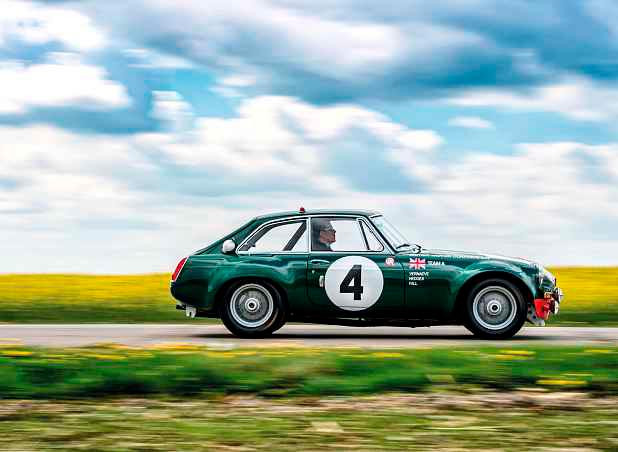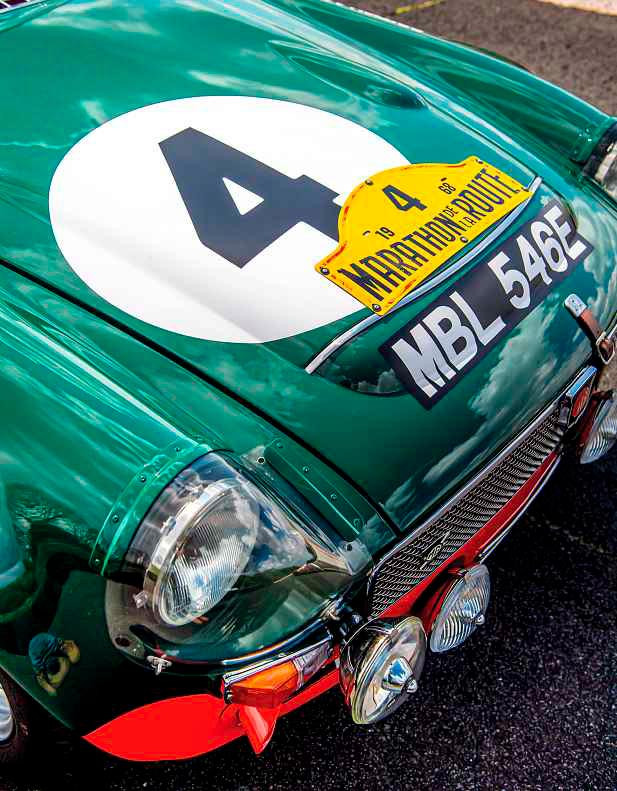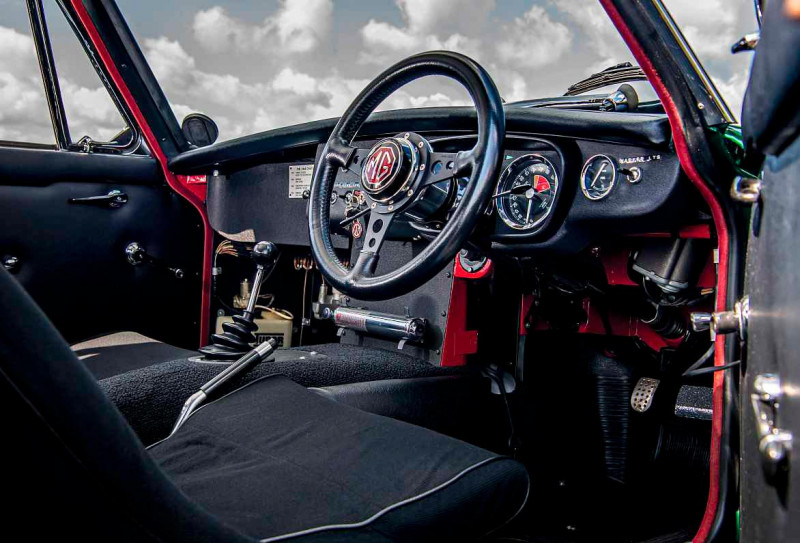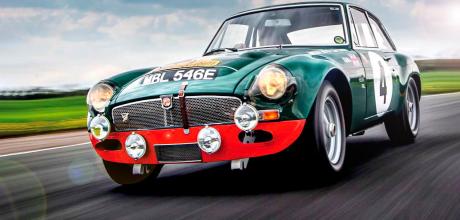1967 MGC GTS - Works rack-testing the brilliant ex-Sebring racer
The short-lived MGC suffered a poor reputation as a driver’s car. The racing GTS suggests it could have been so much greater, as Richard Meaden discovers.
Photography Andrew Morgan
THE FULL WORKS
WORKS MGC GTS Track-testing the brilliant ex-Sebring racer
For a glorious spell during the 1960s, the British Motor Corporation enjoyed an exceptional period of overseas motorsport success. Fuelled by the desire to promote export sales in the USA and Europe and facilitated by a talented team of engineers and drivers, the BMC Competitions Department was a force to be reckoned with on the international race and rally scenes.


‘NOT SURPRISINGLY, THERE’S SOMETHING OF THE BABY E-TYPE ABOUT THE MGC GTS’
While the giant-slaying antics of the Monte-winning Mini-Cooper S came to define the Competitions Department’s efforts in the eyes of the wider public, the Abingdon-based outfit fielded a raft of impressive and versatile machinery. They ranged from the aptly named ‘Big Healeys’, which revelled in rallying and long-distance road races, to numerous MGs that also proved adept at circuit and stage driving. Even the unlikely Austin 1800 saloon got the Abingdon treatment to compete in the gruelling London-Sydney Marathon.

Among the most appealing – not to mention last – of the cars built by the Competitions Department cars was the Lightweight MGC GTS. The car you’re admiring is the first of only two cars built, chassis number ADO 52/1060, but affectionately nicknamed Mabel on account of its registration number, MBL 546E.
Between 1967 and 1969 Mabel raced successfully in four blue riband endurance races, scoring some deeply impressive results in the hands of some of the quickest and most celebrated drivers of the period. MBL’s first outing was on the 1967 Targa Florio, where somewhat confusingly it was entered as an MG GTS (the S standing for ‘Special’, not Sebring, as is commonly suggested; also hence the ‘missing’ C from the tailgate badge) and ran with a special 2004cc four-cylinder B-series engine and the flat MGB bonnet. The reason? Because the six-cylinder MGC road car was still secret at that time.

A further quirk of this early outing is that Mabel was originally painted Tartan Red, in fine BMC Competitions Department tradition. Then came a last-minute request from the Targa organisers, who requested that the car didn’t run in Italian national racing colours. A hasty switch to British Racing Green appeased the locals, and also accounts for the engine bay, interior and floorpan remaining red!
By 1968 it was running in full MGC GTS specification (more on which shortly). At Sebring in the famous 12 Hour endurance race, Paddy Hopkirk and Andrew Hedges achieved an outstanding class win that saw them in tenth place overall. Later that year MBL tackled the fearsome 84-hour Marathon de la Route at the Nürburgring, where Tony Fall and Julien Vernaeve managed a tremendous sixth overall. Its final outing was at Sebring in 1969, driven by the less-than-stellar pairing of Craig Hill and Bill Brack to sixth in class and 34th overall. A truer indication of the GTS’s potential that year can be seen in its sister Lightweight, RMO 699F, which took 15th overall.

Having completed the race, both cars were sold to BMC’s US distributor. Incredibly, they remained unsold for a number of years and, having subsequently passed through a number of hands, MBL was treated to a fully documented rotisserie restoration at Symbolic Motors in La Jolla, San Diego, between 2009 and 2012 by previous owner Henry Camisasca. The car is now back in the UK and owned by Rick Hall, proprietor of Hall & Hall.
Given that the MGC road car was blessed with rather less athleticism than its six-cylinder engine promised, the Competitions Department really went to town on the GTS in order to make it a contender. Most radical of the changes was to the body, which retained the central section of the MGC’s steel structure but was clad in new aluminium exterior panels, including the roof, doorskins, front valance, rear hatch and – of course – the extravagantly flared front and rear wheelarches. The bonnet was also aluminium, but this was a standard-fit item on the MGC, presumably as an attempt to mitigate the hefty weight of the 3.0-litre straight-six beneath it. In race tune the C-series engine developed a little over 200bhp – 55-60bhp more than the standard engine. This was achieved by a fractional overbore and recessed piston crowns, which took capacity to 2968cc (up from 2912cc). A seven-bearing crankshaft, plus lightened and balanced conrods, flywheel and clutch assembly, ensured sweeter revving and a snappier throttle response.
To save weight the cylinder head was recast in aluminium, and the compression ratio was increased to 10.25:1. Stronger valve springs and modified rocker assemblies raised the rev limit to 6750rpm, while added snort was provided by a bank of triple 45 DCOE Weber carburettors attached to the new head via their own individual alloy inlet manifolds.
Later in the programme further weight-saving efforts came in the form of special alloy engine blocks. As is so often the case when development is done on the hoof (and on a shoestring) there is some debate over exactly how many engines were made, and which cars they were fitted to, though it would appear that it was RMO and not MBL that used the all-alloy development engine in anger. The new lightweight body was designed by Don Hayter, stylist of the MGB and credited with helping to pen the Aston Martin DB2/4 and DB4. Prior to his stint at Feltham, Hayter had worked on design details of the Avro Lancaster and Supermarine Spitfire. Not a bad CV.
There’s certainly a fusion of grace and function about the GTS that’s incredibly appealing to the eye. The oversized bubble ’arches are prescient of those attached to Ford’s Escort Mk1 rally cars – no coincidence, as BMC’s Competition Department supremo, Stuart Turner, subsequently founded Ford’s AVO Department after leaving BMC. They give the underlying MGB GT shape an abundance of muscle. In truth they actually appear to be oversized for the wheels and tyres fitted. It suggests a degree of future-proofing in the event of the C needing more rubber on the road, but I’ve failed to unearth any evidence to support my hunch. Perhaps the Octane hivemind can help?
The ’arches are the defining feature, but it’s the details that provide endless joy. MBL is peppered with racing add-ons: fixed jacking points to aid pit stops, a roof-mounted marker light to distinguish it from RMO when racing at night, two pairs of auxiliary driving lamps, and the large alloy filler cap that protrudes from the righthand C-pillar. The whole car screams ‘works racer’.
There’s just as much to enjoy inside, with the large spare wheel strapped on top of the huge 24-gallon fuel tank, low-cut bucket seats, basic roll-cage and neatly labelled toggle switches getting you in the mood to attack Circuito Piccolo delle Madonie in front of half a million baying Sicilians. Or, indeed, Blyton Park on a sunny summer’s day.
Such was the weakening effect of the lightweight aluminium panels that the MGC’s structure could flex alarmingly when subjected to significant cornering loads, especially at the Nürburgring Nordschleife. As you can imagine, this was something of a problem for a racing car, especially one fitted with extra-wide wheels and tyres to increase grip. Not only would the bonnet twist its way open (forcing the team to attach a leather strap to keep it closed) but on occasion the doors would burst open, too!
The fix? A pair of brass cupboard slide bolts, which I’m advised to slot into their keeps once in the car. Not to be left out, the tailgate is secured with a leather strap. While this flex wouldn’t have helped with the MGC’s ultimate handling, given the rough-and-tumble nature of Sebring, Sicily and the Nürburgring, some compliance was probably no bad thing, intentional or not.
Perhaps not surprisingly, there’s something of the baby E-type about the MGC GTS. The lusty straight-six doesn’t have the Jag’s shove, but it propels the C enthusiastically, a crisp bark from the twin exhaust pipes bolstered by the throaty snort from those hungry Webers. It’s a soundtrack evocative of the 1960s and certainly forgives those who were seduced by the notion of a beefed-up B with a lot more muscle.
There’s plenty of torque, so you can happily let the engine work through its mid-range without being tempted to drop down a gear, but it’s also happy to nudge the tacho needle towards the graduated orange-to-redline if you need to hold a gear between corners.
Like with racing MGBs, there’s a friendliness to the C GTS that suggests it would have been a fabulous partner on long-distance races, especially the Targa or Marathon de la Route, on which lengthy stints in a tricky car would have led to premature fatigue and, potentially, a missed gear or mid-corner misjudgement.
The gearshift is sweet and short of throw and the steering has a nice blend of connection and heft that makes it easy to place the car accurately, aiming the nose neatly towards the apex, then making mid-corner corrections as you power towards the exit. There’s certainly little evidence of the MGC’s reputed propensity to understeer, although to be fair Blyton’s corners tend to encourage steering on the throttle – something Mabel clearly enjoys!
What’s apparent is that the GTS is one of those cars you just want to keep driving, with a transparency that quickly builds your confidence and a generosity of character that means you form an immediate bond with the machine. MBL would have competed against much faster and more potent cars, but I doubt their drivers would have developed quite such a connection, nor enjoyed the satisfaction of getting the most from what was a modestly powerful car in comparison to its class rivals. It’s a thoroughly enjoyable drive, more than enough fun that I’d envy Hall and covet his new purchase.
With so little use since its nut-and-bolt restoration MBL looks like a new pin. In truth it’s probably a bit too perfect, or at least in need of a few scuffs and stonechips as signs of living a life at speed. Now that it has been repatriated – something MG enthusiasts have wanted pretty much since MBL and RMO left for Sebring in 1969 – Hall intends to use the car on a few Historic events.
That’s great news, for significant cars such as this need to be seen. Hall’s enthusiastic driving will surely begin the process of MBL acquiring the kind of gentle patina that always sets active Historic competition cars apart from dormant ‘investment grade’ assets.
The closure of BMC’s Competitions Department in 1970 was a bitter moment for all involved, and a sorry way for such a special outfit to end its days. One suspects that the team’s decline and the Lightweight MGCs being the last cars to leave Abingdon somehow cast a shadow over Project EX241. It’s not hard to see how stretched finances coupled with the road car’s well-documented inadequacies left the resulting pair of GTSs fighting more than just the opposition, yet those stand-out results at Sebring, Targa Florio and the Marathon de la Route point to a fine car that deserved more support and development. Motorsport is riven with tales of what might have been.
There’s certainly a sense of unfinished business about the MGC’s racing exploits. But if you subscribe to the old adage ‘if it looks right, it is right’ then the handsome, charismatic GTS is sure to win you over. If you’ve got a drop of petrol in your veins it is impossible to resist. That the MGC tends to get overlooked in the grand scheme of BMC’s wider competition achievements does the last Abingdon MG racer a great disservice. Perhaps now that MBL is back in Britain, it will serve to remind us how special these Lightweight MGCs are.
THANKS TO Hall & Hall, hallandhall.net.
Top and above GTS was fully restored in 2012 and will finally be put to use on the track again in Historic racing; Don Hayter’s reworking of his own styling certainly looks the part. Left and below Aluminium panels save weight, oversize wheelarches allow wider wheels; 3.0-litre straight-six stretched, strengthened, lightened, balanced to be good for 202bhp.
TECHNICAL DATA 1967 MGC GTS
- Engine 2968cc OHV straight-six, triple Weber 45 DCOE carburettors
- Max Power 202bhp @ 6000rpm
- Max Torque 145lb ft @ 3400rpm
- Transmission Four-speed manual, rear-wheel drive, limited-slip differential
- Steering Rack and pinion
- Suspension Front: upper wishbones, lower transverse links, torsion bar,
- telescopic dampers, anti-roll bar. Rear: live axle, semi-elliptic leaf springs, lever-arm dampers
- Brakes Girling discs
- Weight c1000kg
- Top speed c130mph
‘PADDY HOPKIRK AND ANDREW HEDGES ACHIEVED AN OUTSTANDING CLASS WIN AT SEBRING’
Clockwise, from above Bonnet hump clears straight-six beneath; GTS handles somewhat better than standard MGC; its first outing, the 1967 Targa Florio, driven by Paddy Hopkirk with Timo Mäkinen, with a tuned B-series and MGB bonnet…



Canuck champs
Richard Meaden’s throwaway line about one of the works MGC GTS cars being driven by ‘the less-than-stellar’ pairing of Craig Hill and Bill Brack at Sebring in 1969 does both of them a serious disservice.
Bill Brack was the Canadian distributor for Lotus and a BMC dealer in the Toronto area, who competed successfully in Minis, a Lotus 47, ex-Graham Hill Lotus 42B Indycar and Lotus 70. He won the Player’s Challenge Series in 1973 and ’74 and, when the series was upgraded to Formula Atlantic, he won it two more years in a row. It took some kid named Gilles Villeneuve to finally beat him to the championship.
Craig Hill is also a member of the Canadian Motorsport Hall of Fame. Having cut his racing teeth on dirt tracks and asphalt, he was the Canadian Formula B champ in 1969 and ’70 and graduated to the Player’s Challenge Series in a Lotus 69B and then a Brabham BT 40, and finally a March 75BT in Formula Atlantic.
Meaden’s research must have come solely from the results sheet because, in qualifying, Hill and Brack were almost four seconds faster than Hopkirk and Hedges. Yes, sister car ‘699F’ finished 26 laps ahead, but I cannot imagine that was all due to driver talent.